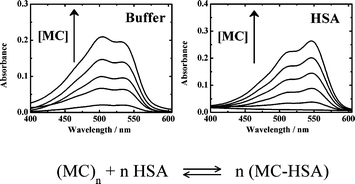Photobehavior of merocyanine 540 bound to human serum albumin
Abstract
The photobehavior of

* Corresponding authors
a Department of Chemistry and Centre for Catalysis Research and Innovation, 10, Marie Curie, K1N 6N5, University of Ottawa, Ottawa, Ontario, Canada
b
Departamento de Ciencias del Ambiente, Facultad de Química y Biología, Universidad de Santiago de Chile, USACH, Av. Bernardo O'Higgins, Santiago, Chile
E-mail:
eduardo.lissi@usach.cl
c Departamento de Química Física, Facultad de Química, Pontificia Universidad Católica de Chile, Santiago, Chile
The photobehavior of

 Please wait while we load your content...
Something went wrong. Try again?
Please wait while we load your content...
Something went wrong. Try again?
E. Alarcón, A. Aspée, M. González-Béjar, A. M. Edwards, E. Lissi and J. C. Scaiano, Photochem. Photobiol. Sci., 2010, 9, 861 DOI: 10.1039/C0PP00079E
To request permission to reproduce material from this article, please go to the Copyright Clearance Center request page.
If you are an author contributing to an RSC publication, you do not need to request permission provided correct acknowledgement is given.
If you are the author of this article, you do not need to request permission to reproduce figures and diagrams provided correct acknowledgement is given. If you want to reproduce the whole article in a third-party publication (excluding your thesis/dissertation for which permission is not required) please go to the Copyright Clearance Center request page.
Read more about how to correctly acknowledge RSC content.
 Fetching data from CrossRef.
Fetching data from CrossRef.
This may take some time to load.
Loading related content
